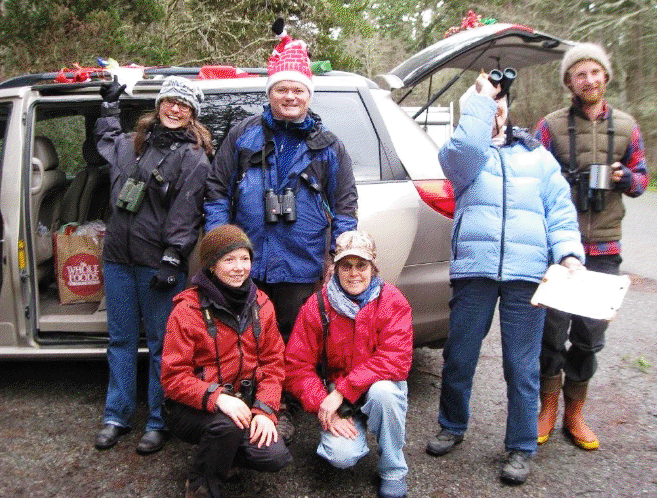
Lopez Bird Counters, December 2011
By Barbara Jensen, President San Juan Islands Audubon
Saturday, December 15 is the date for this year’s Christmas Bird Count (CBC) in the San Juan Islands.
Over 60,000 volunteers across the country will be counting birds from December 14, 2012 to January 5, 2013 to participate in the world’s longest running wildlife census begun in 1900.
Local Count – Each count area is a 15-mile diameter circle – about 177 square miles with the San Juan circle centered at the Friday Harbor Labs. Areas are assigned to teams but you don’t necessarily have to go out with a group – you could count birds on your road with your neighbors or by yourself or with your family in your own yard or on your property. We also want people to send in their feeder reports. You don’t have to be an expert but you do have to have enthusiasm for nature.
Even if you don’t count please let us know if you see any of these species three days on each side of the count day or let us know ahead of time if they are in your area so we can look for them: small hawks, mourning doves, owls, hummingbirds, sapsuckers, shrikes, jays, western bluebirds or any out of place or out of season bird. If you live on the shoreline we need your help with shorebirds and marine birds. To sign up, contact Barbara Jensen at 378-3068.
National and International Counts – This CBC will be larger than ever, expanding its geographical coverage. Volunteers from all 50 states, every Canadian province, parts of Central and South America, Bermuda, the West Indies, and Pacific Islands, count and record every individual bird and bird species seen in a specified area.
Several changes have been made to entice birdwatchers to participate. The $5 fee will be dropped, the annual published report, American Birds, will go digital in 2013, and the online information will be available in Spanish for the first time.
“This is not just about counting birds,” says Gary Langham, Audubon’s chief scientist. “Data from the Audubon Christmas Bird Count are at the heart of hundreds peer-reviewed scientific studies and inform decisions by the U.S. Fish and Wildlife Service, the Department of the Interior, and the EPA. Because birds are early indicators of environmental threats to habitats we share, this is a vital survey of North America and, increasingly, the Western Hemisphere.”
CBC revealed the dramatic impact climate change is already having on birds and a disturbing decline in common birds. The many decades of data not only help identify birds in need of conservation action, it also reveals success stories. CBC helped document the comeback of the Bald Eagle and significant increases in waterfowl populations, both the result of conservation efforts.
Last year’s count shattered records with a total of 2,248 counts and 63,227 people tallied over 60 million birds. Counts took place in all 50 states, all Canadian provinces, plus 99 count circles in Latin America, the Caribbean, and the Pacific Islands. In Colombia, the Christmas Bird Count is a crucially important monitoring system of biodiversity in the country.
Many routes need better coverage so call today to see what we have for you. For more information and to join call: Barbara Jensen, 378-3068.
**If you are reading theOrcasonian for free, thank your fellow islanders. If you would like to support theOrcasonian CLICK HERE to set your modestly-priced, voluntary subscription. Otherwise, no worries; we’re happy to share with you.**







